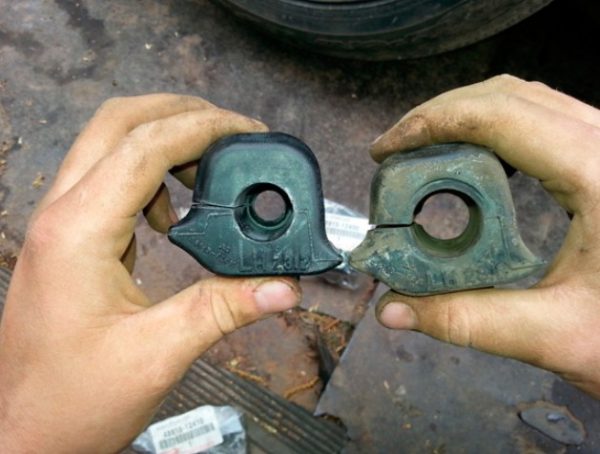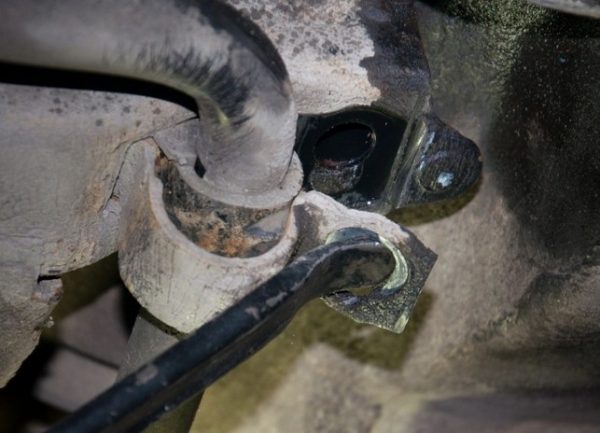
We independently change the bushings on the rear stabilizer VAZ 2107
Content
The VAZ 2107 car has never been distinguished by increased cornering stability. Car owners, in an attempt to improve this situation, go to all sorts of tricks. One of these tricks is the installation on the "seven" of the so-called anti-roll bars. Is such tuning advisable, and if so, how to do it correctly? Let's try to figure it out.
What is a rear stabilizer
The rear stabilizer for the VAZ 2107 is a curved c-shaped bar, installed next to the rear axle of the "seven". The stabilizer is attached at four points. Two of them are located on the rear suspension arms, two more - on the rear spars of the "seven". These mounts are ordinary lugs with dense rubber bushings inside (these bushings are the weak point of the whole structure).

Today, you can buy a rear stabilizer and fasteners for it at any parts store. Some drivers prefer to make this device on their own, but this is a very time-consuming process that requires certain skills that a novice motorist simply does not have. That is why the replacement of bushings on the finished stabilizer will be discussed below.
The purpose of the rear stabilizer
The anti-roll bar on the "seven" performs two important functions at once:
- this device gives the driver the opportunity to control the slope of the car chassis, while the force acting on the camber of the rear wheels practically does not increase;
- after installing the stabilizer, the slope of the suspension between the axles of the car changes significantly. As a result, the driver is able to better control the car;
- The improvement in vehicle control is especially noticeable in tight corners. After installing the stabilizer, not only does the lateral roll of the car decrease at such turns, but they can also be passed at a higher speed.
About the cons of the rear stabilizer
Speaking about the pluses that the stabilizer gives, one cannot fail to mention the minuses, which are also available. In general, the installation of a stabilizer is still the subject of fierce debate between motorists. Opponents of the installation of stabilizers usually argue their position with the following points:
- yes, after installing the rear stabilizer, lateral stability increases significantly. But this is a double-edged sword, since it is the high lateral stability that greatly facilitates the breakdown of the car into a skid. This circumstance is good for those who are engaged in the so-called drifting, but for an ordinary driver who finds himself on a slippery road, this is absolutely useless;
- if a motorist decides to install a rear stabilizer on his "seven", then he is strongly recommended to install a front one, and not a regular one, but a double one. This measure will help prevent excessive loosening of the car body;
- the passability of a car with stabilizers is reduced. On sharp turns, such a car often begins to cling to the ground or snow with stabilizers.
 It is easy to see that the ground clearance of the VAZ 2107 with a stabilizer decreases, which affects the patency
It is easy to see that the ground clearance of the VAZ 2107 with a stabilizer decreases, which affects the patency
Thus, a driver who is thinking about installing stabilizers should weigh the pros and cons as carefully as possible, and only then make a final decision.
Signs of a broken rear stabilizer
It is easy to guess that something is wrong with the rear stabilizer VAZ 2107. Here is what is observed:
- a characteristic rattle or creak, which is especially clearly audible when entering a sharp turn at high speed;
- a significant increase in vehicle roll when cornering and a decrease in controllability when cornering;
- the appearance of play on the stabilizer. Play can be easily found by putting the car on a viewing hole and simply shaking the stabilizer bar up and down;
- bushing destruction. The backlash, which was mentioned above, is almost always accompanied by the destruction of rubber bushings. They are squeezed out of their eyes, cracked and completely cease to perform their functions.
 On the right is a worn stabilizer bushing, the hole in which is much larger than in the new bushing on the left
On the right is a worn stabilizer bushing, the hole in which is much larger than in the new bushing on the left
All of the above things say only one thing: it's time to repair the stabilizer. In the vast majority of cases, the repair of the rear stabilizer comes down to replacing damaged bushings, since the fasteners and the rod need to be repaired extremely rarely. Such a need may arise only in the event of serious mechanical damage, when the driver has caught a large stone or curb with the stabilizer, for example.
How should the stabilizer be?
A properly installed stabilizer should be able to twist under the action of forces on the wheels, and it should do this even when the forces applied to the right and left wheels are directed at completely different angles.
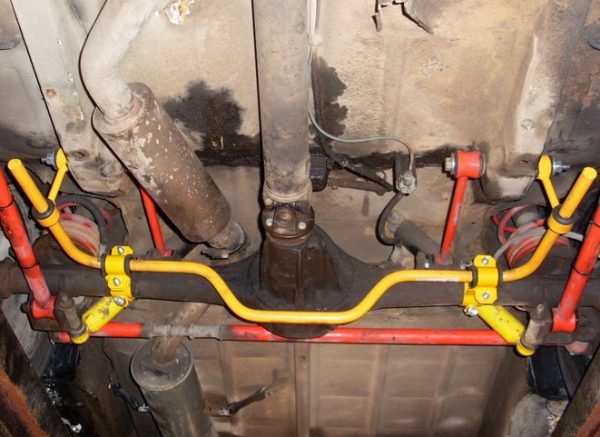
That is, the stabilizers on passenger cars should never be directly welded to the frame, there should always be some kind of intermediate link between the frame and the wheel mount, which is responsible for compensating multidirectional forces. In the case of the VAZ 2107, such a link is dense rubber bushings, without which it is strongly not recommended to operate the stabilizer.
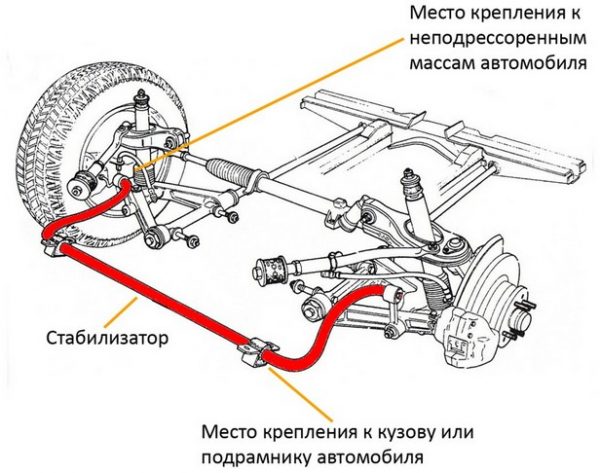
Why squeezes out the stabilizer bushings
As mentioned above, the bushings on the stabilizer serve to compensate for the forces exerted on the wheels. These efforts can reach enormous values, especially at the moment the car enters a sharp turn. Rubber, even of very high quality, systematically subjected to huge alternating loads, inevitably becomes unusable. The destruction of the bushings is also facilitated by severe frosts and reagents that are sprinkled on roads in our country during icy conditions.
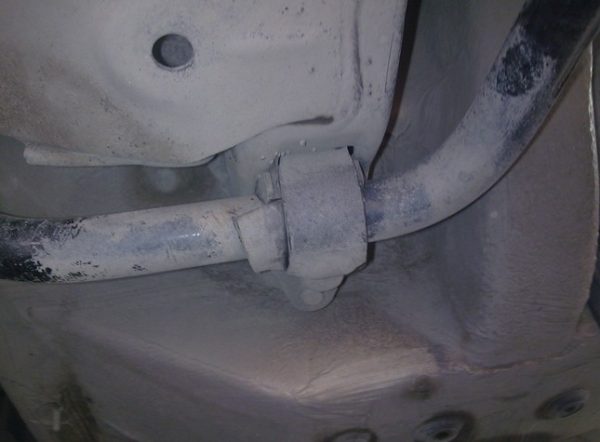
Usually it all starts with cracking the surface of the bushing. If the driver does not notice the problem in time, the cracks become deeper, and the bushing gradually loses its rigidity. At the next sharp turn, this cracked sleeve is squeezed out of the eye and does not return back to it, since the elasticity of the part is completely lost. After that, a backlash appears on the stabilizer bar, the driver hears a creak and rattle when entering a turn, and the car's controllability decreases sharply.
About Dual Stabilizers
Double stabilizers are installed only on the front wheels of the VAZ 2107. As the name implies, there are already two rods in this device. They have the same C-shape and are located about four centimeters apart. Mounting eyes in double stabilizers are also paired. Otherwise, this design has no fundamental differences from the rear stabilizer.
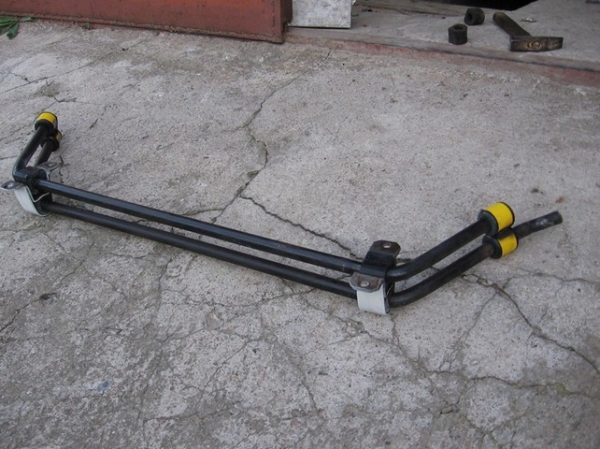
Why put two bars instead of one? The answer is obvious: to increase the overall stiffness of the suspension. The double front stabilizer handles this task perfectly. But it is impossible not to note the problems that arise after its installation. The fact is that the front suspension on the classic "seven" is initially independent, that is, the position of one wheel does not affect the position of the second. After installing a double stabilizer, this situation will change and the suspension will turn from independent into semi-independent: its working stroke will decrease significantly, and in general the control of the machine will become tougher.
Of course, roll when entering corners with a double stabilizer will decrease. But the driver should think about it: is he really ready to sacrifice personal comfort and patency of the car for the sake of its stability? And only after answering this question, you can start working.
Replacing bushings of the rear stabilizer VAZ 2107
Worn rear stabilizer bushings cannot be repaired. They are made of special wear-resistant rubber. It is not possible to restore the surface of this rubber in a garage: the average car enthusiast has neither the appropriate skills nor the appropriate equipment for this. Therefore, there is only one way to solve the problem of worn bushings: replace them. Here are the tools and supplies you will need for this job:
- a set of new bushings for the rear stabilizer;
- set of open-end wrenches;
- flat screwdriver and hammer;
- composition WD40;
- mounting blade.
Sequence of operations
It should be said right away that it is most convenient to carry out all work in a viewing hole (as an option, you can put the car on a flyover).
- After installation on the pit, the stabilizer fasteners are carefully inspected. As a rule, all the bolts on it are covered with a layer of dirt and rust. Therefore, it makes sense to treat all these compounds with WD40 and wait 15 minutes. This time will be enough to dissolve dirt and rust.
- The fixing bolts on the stabilizer clamps are unscrewed with an open-end wrench by 17.
 It is most convenient to unscrew the fixing bolts with an L-shaped wrench by 17
It is most convenient to unscrew the fixing bolts with an L-shaped wrench by 17 - To loosen the stabilizer bar together with the sleeve, the clamp will have to be slightly unbent. To do this, insert a narrow mounting blade into its hole, and using it as a small lever, bend the clamp.
 The clamp on the stabilizer is unbent with a conventional mounting blade
The clamp on the stabilizer is unbent with a conventional mounting blade - After unbending the clamp, you can simply cut off the old sleeve with a knife from the rod.
- The bushing installation site is thoroughly cleaned of dirt and rust. A layer of grease is applied to the inside of the new bushing (this grease is usually sold with bushings). After that, the sleeve is put on the rod and carefully moves along it to the installation site.
 The new bushing is put on the stabilizer bar and slides along it to the clamp
The new bushing is put on the stabilizer bar and slides along it to the clamp - After installing a new bushing, the mounting bolt on the clamp is tightened.
- All of the above operations are performed with the three remaining bushings, and the mounting bolts on the clamps are tightened. If, after installing new bushings, the stabilizer did not warp and there was no play in it, the replacement of the bushings can be considered successful.
Video: replacing stabilizer bushings on the "classic"
So, the anti-roll bar was and remains an extremely controversial element of tuning the classic "seven". Nevertheless, even a novice car enthusiast will not have any difficulties in maintaining this part, since the only wear element of the stabilizer is the bushings. Even a novice driver who has at least once held a mounting spatula and a wrench in his hands can replace them.



